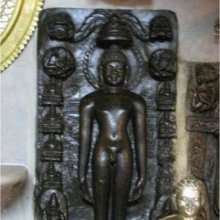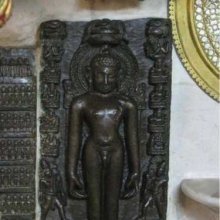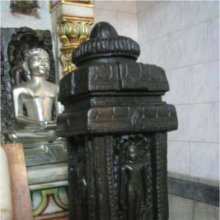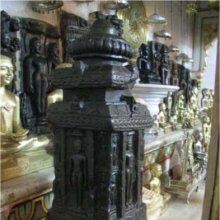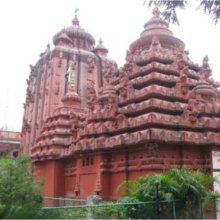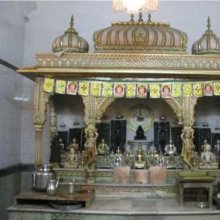Digambara, Dish-ambara: 22 definitions
Introduction:
Digambara means something in Buddhism, Pali, Hinduism, Sanskrit, Jainism, Prakrit, the history of ancient India, Marathi, Hindi. If you want to know the exact meaning, history, etymology or English translation of this term then check out the descriptions on this page. Add your comment or reference to a book if you want to contribute to this summary article.
Alternative spellings of this word include Digambar.
Images (photo gallery)
(+11 more images available)
In Hinduism
Shaktism (Shakta philosophy)
Source: Google Books: Manthanabhairavatantram1) Digambara (दिगम्बर) refers to “one who is naked”, according to the second recension of the Yogakhaṇḍa of the Manthānabhairavatantra, a vast sprawling work that belongs to a corpus of Tantric texts concerned with the worship of the goddess Kubjikā.—Accordingly, as the Goddess (i.e., Khageśī) said to the God (i.e., Bhairava), “[...] Being one who has matted hair, shaved head, (having a) topknot, carrying a skull, smeared with ashes or wearing the five insignias—O god, (none of this) leads to accomplishment in the Kula tradition. (Even) a renouncer who does not bear the five insignias and is naked [i.e., Digambara] does not quickly achieve success in the western (transmission) of the House of the Yoginīs. This is forbidden and (so) all this is absent in the Kaula (teachings). O Maheśvara, as this is improper how can the Command be given to you?”.
2) Digambara (दिगम्बर) refers to one of the eight Servants (ceṭa-aṣṭaka) associated with Nādapīṭha (identified with Kulūta), according to the Manthānabhairavatantra.—[...] The eight Servants (ceṭāṣṭaka): Śuṣkaruṇḍa, Dīrghajaṅgha, Digambara, Mālādhara, Mahāmuṇḍa, Caṇḍa, Caṇḍaparākrama, Śukatuṇḍa.
Source: Red Zambala: The 10 Great Wisdom GoddessesWhen the universe is dissolved (pralaya), the Power of Time (Kālī) remains without a veil, naked. Hence the Goddess is “clad in space” (Digambara), having the vast emptiness of space as her only vesture.

Shakta (शाक्त, śākta) or Shaktism (śāktism) represents a tradition of Hinduism where the Goddess (Devi) is revered and worshipped. Shakta literature includes a range of scriptures, including various Agamas and Tantras, although its roots may be traced back to the Vedas.
Ayurveda (science of life)
Rasashastra (Alchemy and Herbo-Mineral preparations)
Source: Wisdom Library: Rasa-śāstraDigambara (दिगम्बर) or Digambararasa is the name of an Ayurvedic recipe defined in the fourth volume of the Rasajalanidhi (chapter 2, dealing with jvara: fever). These remedies are classified as Iatrochemistry and form part of the ancient Indian science known as Rasaśāstra (medical alchemy). However, since it is an ayurveda treatment it should be taken with caution and in accordance with rules laid down in the texts.
Accordingly, when using such recipes (e.g., digambara-rasa): “the minerals (uparasa), poisons (viṣa), and other drugs (except herbs), referred to as ingredients of medicines, are to be duly purified and incinerated, as the case may be, in accordance with the processes laid out in the texts.” (see introduction to Iatro chemical medicines)

Āyurveda (आयुर्वेद, ayurveda) is a branch of Indian science dealing with medicine, herbalism, taxology, anatomy, surgery, alchemy and related topics. Traditional practice of Āyurveda in ancient India dates back to at least the first millenium BC. Literature is commonly written in Sanskrit using various poetic metres.
Purana and Itihasa (epic history)
Source: archive.org: Shiva Purana - English TranslationDigambara (दिगम्बर) refers to “having a naked form”, according to the Śivapurāṇa 2.5.13 (“Resuscitation of Indra”).—Accordingly, as Sanatkumāra narrated to Vyāsa: “O sage, once Bṛhaspati and Indra went to Kailāsa with great devotion, to see lord Śiva. Coming to know of the arrival of Bṛhaspati and Indra eager to see him, lord Śiva wished to test their knowledge. Accordingly, the lord, the excellent goal of the good, stood blocking their path in the naked form (digambara) with matted hair and beaming face. [...]”.

The Purana (पुराण, purāṇas) refers to Sanskrit literature preserving ancient India’s vast cultural history, including historical legends, religious ceremonies, various arts and sciences. The eighteen mahapuranas total over 400,000 shlokas (metrical couplets) and date to at least several centuries BCE.
In Buddhism
Tibetan Buddhism (Vajrayana or tantric Buddhism)
Source: MDPI Books: The Ocean of HeroesDigambarā (दिगम्बरा) refers to “she who is naked”, according to the 10th-century Ḍākārṇava-tantra: one of the last Tibetan Tantric scriptures belonging to the Buddhist Saṃvara tradition consisting of 51 chapters.—Accordingly, [while describing the Adamantine Circle (vajracakra)]: “ [Every] Yoginī on all [twelve] circles—she [has] four arms, [has] one face, holds a skull bowl and a skull staff [in the two left hands], also [holds] a small drum and a knife [in the two right hands], [has her] hair untied, is naked (digambarā), [has her] body [ornamented with] the five seals, is adorned with a string of vajras, stands on a corpse, and is very terrifying; [she] wears various [good] ornaments and is a wisdom accompanying a means (her male consort). [...]”.

Tibetan Buddhism includes schools such as Nyingma, Kadampa, Kagyu and Gelug. Their primary canon of literature is divided in two broad categories: The Kangyur, which consists of Buddha’s words, and the Tengyur, which includes commentaries from various sources. Esotericism and tantra techniques (vajrayāna) are collected indepently.
In Jainism
General definition (in Jainism)
Source: WikiPedia: JainismDigambara refers to one of the two major schools of Jainism, the other being Śvetāmbara. The Sanskrit word Digambara means “sky-clad”, referring to their traditional monastic practice of neither possessing nor wearing any clothes.—Digambara monks cherish the virtue of non-attachment and non-possession of any material goods. Monks carry a community-owned picchi, which is a broom made of fallen peacock feathers for removing and thus saving the life of insects in their path or before they sit. [...] The Digambara sect of Jainism rejects the texts and canonical literature of the Svetambara sect. They believe that the words of Mahavira neither survive nor could be recorded. The original teachings went through a rapid period of decline, state the Digambaras, and Svetambara claims of preserving the sacred knowledge and ancient angas is false.

Jainism is an Indian religion of Dharma whose doctrine revolves around harmlessness (ahimsa) towards every living being. The two major branches (Digambara and Svetambara) of Jainism stimulate self-control (or, shramana, ‘self-reliance’) and spiritual development through a path of peace for the soul to progess to the ultimate goal.
India history and geography
Source: Cologne Digital Sanskrit Dictionaries: Indian Epigraphical GlossaryDigambara.—(IA 7), a Jain sect. Note: digambara is defined in the “Indian epigraphical glossary” as it can be found on ancient inscriptions commonly written in Sanskrit, Prakrit or Dravidian languages.

The history of India traces the identification of countries, villages, towns and other regions of India, as well as mythology, zoology, royal dynasties, rulers, tribes, local festivities and traditions and regional languages. Ancient India enjoyed religious freedom and encourages the path of Dharma, a concept common to Buddhism, Hinduism, and Jainism.
Languages of India and abroad
Pali-English dictionary
Source: BuddhaSasana: Concise Pali-English Dictionarydigambara : (m.) a naked ascetic.

Pali is the language of the Tipiṭaka, which is the sacred canon of Theravāda Buddhism and contains much of the Buddha’s speech. Closeley related to Sanskrit, both languages are used interchangeably between religions.
Marathi-English dictionary
Source: DDSA: The Molesworth Marathi and English Dictionarydigambara (दिगंबर).—a (S dig from diś Space, ambara Clothing.) Naked. 2 A name of Mahadeva.
Source: DDSA: The Aryabhusan school dictionary, Marathi-Englishdigambara (दिगंबर).—a Naked. A name of mahādēva.
Marathi is an Indo-European language having over 70 million native speakers people in (predominantly) Maharashtra India. Marathi, like many other Indo-Aryan languages, evolved from early forms of Prakrit, which itself is a subset of Sanskrit, one of the most ancient languages of the world.
Sanskrit dictionary
Source: DDSA: The practical Sanskrit-English dictionaryDigambara (दिगम्बर).—a. having only the directions for his clothing, stark naked, unclothed; दिगम्बरत्वेन निवेदितं वसु (digambaratvena niveditaṃ vasu) Kumārasambhava 5.72; एकाकी गृहसंत्यक्तः पाणिपात्रो दिगम्बरः (ekākī gṛhasaṃtyaktaḥ pāṇipātro digambaraḥ) Pañcatantra (Bombay) 5.15; Manusmṛti 11.21. (-raḥ) 1 a naked mendicant (of the Jaina or Buddha sect.)
2) a mendicant, an ascetic.
3) an epithet of (1) Śiva; (2) Skanda.
4) darkness.
Digambara is a Sanskrit compound consisting of the terms diś and ambara (अम्बर). See also (synonyms): digvāsas.
Source: Cologne Digital Sanskrit Dictionaries: Shabda-Sagara Sanskrit-English DictionaryDigambara (दिगम्बर).—mfn.
(-raḥ-rā-rī-raṃ) 1. Naked, unclad, unclothed. 2. Dressed in, or enveloped by the atmosphere, clouds, &c. m.
(-raṃ) 1. A Bauddha mendicant, wearing coloured clothes, or going naked. 2. Any mendicant not wearing clothes. 3. Darkness. 4. A name of Siva, (from his being naked.) 5. A Jain of one great division, which represents the images of their saints, either naked or plainly attired. f. (-rī) A name of Durga. E. dik inflection of diś space, ambara vestment; whose only garment is the atmosphere. dik śūnyamambaraṃ yasya .
Source: Cologne Digital Sanskrit Dictionaries: Benfey Sanskrit-English DictionaryDigambara (दिगम्बर).—i. e. diś-ambara, I. adj., f. rā, Naked, [Pañcatantra] v. [distich] 14. Ii. m. An ascetic, [Prabodhacandrodaya, (ed. Brockhaus.)] 46, 5.
Source: Cologne Digital Sanskrit Dictionaries: Cappeller Sanskrit-English DictionaryDigambara (दिगम्बर).—[adjective] unclad, naked (lit. sky-clothed), [abstract] tva [neuter]; [masculine] a naked mendicant.
Source: Cologne Digital Sanskrit Dictionaries: Aufrecht Catalogus Catalogorum1) Digambara (दिगम्बर) as mentioned in Aufrecht’s Catalogus Catalogorum:—grammarian. Quoted in Gaṇaratnamahodadhi p. 441. Compare Digvastra.
2) Digambara (दिगम्बर):—father of Śiva Dīkṣita (Adhikaraṇamālārthaprakāśikā).
Source: Cologne Digital Sanskrit Dictionaries: Monier-Williams Sanskrit-English Dictionary1) Digambara (दिगम्बर):—[=dig-ambara] [from dig > diś] mfn. ‘sky clothed’ id est. quite naked, [Bhartṛhari iii, 90; Pañcatantra v, 14]
2) [v.s. ...] m. (also -ka) a naked mendicant ([especially] of the Jaina or Bauddha sect cf. 1. kṣapaṇa), [Prabodha-candrodaya; Vetāla-pañcaviṃśatikā] etc., [Monier-Williams’ Buddhism 530 etc.]
3) [v.s. ...] Name of Śiva or Skanda, [cf. Lexicographers, esp. such as amarasiṃha, halāyudha, hemacandra, etc.]
4) [v.s. ...] of a grammarian, [Gaṇaratna-mahodadhi]
5) [v.s. ...] darkness, [cf. Lexicographers, esp. such as amarasiṃha, halāyudha, hemacandra, etc.]
Source: Cologne Digital Sanskrit Dictionaries: Yates Sanskrit-English DictionaryDigambara (दिगम्बर):—[diga+mbara] (raḥ) 1. m. A naked mendicant; Shiva. f. (rī) Durgā. a. Naked, clothed with the horizon.
Source: DDSA: Paia-sadda-mahannavo; a comprehensive Prakrit Hindi dictionary (S)Digambara (दिगम्बर) in the Sanskrit language is related to the Prakrit word: Diaṃbara.
[Sanskrit to German]
Sanskrit, also spelled संस्कृतम् (saṃskṛtam), is an ancient language of India commonly seen as the grandmother of the Indo-European language family (even English!). Closely allied with Prakrit and Pali, Sanskrit is more exhaustive in both grammar and terms and has the most extensive collection of literature in the world, greatly surpassing its sister-languages Greek and Latin.
Hindi dictionary
Source: DDSA: A practical Hindi-English dictionaryDigaṃbara (दिगंबर) [Also spelled digambar]:—(a) lit. clad in or covered by space—unclad; stark naked; (nm) an epithet of lord Shiv; a sect of Jainism.
...
Kannada-English dictionary
Source: Alar: Kannada-English corpusDigaṃbara (ದಿಗಂಬರ):—
1) [noun] the state or fact of being naked; nakedness; nudity.
2) [noun] a man who is naked.
3) [noun] one of the formidable form of Śiva.
4) [noun] complete darkness.
5) [noun] the sky.
6) [noun] a Jaina mendicant.
Kannada is a Dravidian language (as opposed to the Indo-European language family) mainly spoken in the southwestern region of India.
See also (Relevant definitions)
Partial matches: Dish, Dig, Ambara.
Starts with: Digambara bhatta, Digambaraka, Digambaranucara, Digambararasa, Digambaratva, Tikamparam, Tikamparavati.
Ends with: Gauridigambara, Gitadigambara, Nagnadigambara.
Full-text (+880): Digvasas, Digambaratva, Shvetambara, Anambara, Tikamparam, Digambaraka, Digambari, Shyama, Angabahira, Vatarashana, Digambar, Ditthivaya, Acyuta, Suvarna, Nandishvaradvipa, Vairotya, Angapaittha, Digvasana, Kalpa, Bhutavadika.
Relevant text
Search found 45 books and stories containing Digambara, Dish-ambara, Diś-ambara, Dis-ambara, Dig-ambara, Digaṃbara; (plurals include: Digambaras, ambaras, Digaṃbaras). You can also click to the full overview containing English textual excerpts. Below are direct links for the most relevant articles:
A study of the philosophy of Jainism (by Deepa Baruah)
Chapter I.d - Two sects of Jainism (Śvetāmbara and Digambara) < [Chapter I - Introduction]
Chapter I.e - Religious and philosophical literature of the Jainas < [Chapter I - Introduction]
Chapter I.c - The lives of the Tīrthaṅkaras < [Chapter I - Introduction]
Jain Remains of Ancient Bengal (by Shubha Majumder)
Jainism after the death of Mahāvīra < [Chapter 3 - Historical Background of Jainism in Ancient Bengal]
Historical Development of Jainism < [Chapter 1 - Introduction and Scope of the Present Study]
Jainism in ancient Bengal during the Gupta Period < [Chapter 3 - Historical Background of Jainism in Ancient Bengal]
Dasarupaka (critical study) (by Anuru Ranjan Mishra)
Part 7 - Characters in the Mudritakumudacandra < [Chapter 10 - Prakaraṇa (critical study)]
Part 2 - Summary of the drama (Mudritakumudacandra) < [Chapter 10 - Prakaraṇa (critical study)]
Part 8 - Styles (vṛtti) of the Prakaraṇa < [Chapter 10 - Prakaraṇa (critical study)]
The Tattvasangraha [with commentary] (by Ganganatha Jha)
Verse 311 (the doctrine of ‘Soul’ according to the Digambara Jainas) < [Chapter 7 - Doctrine of the Self (ātman, ‘soul’)]
Verse 1980-1983 < [Chapter 23 - External World]
Verse 3151-3153 < [Chapter 26 - Examination of the ‘Person of Super-normal Vision’]
Garga Samhita (English) (by Danavir Goswami)
Verse 8.13.98 < [Chapter 13 - A Thousand Names of Lord Balarāma]
Jainism in Odisha (Orissa) (by Ashis Ranjan Sahoo)
Jain Iconography in Odisha (Introduction) < [Chapter 6]
Iconography of Tirthankaras < [Chapter 6]
Iconography of Jain Gods and Goddess < [Chapter 6]
